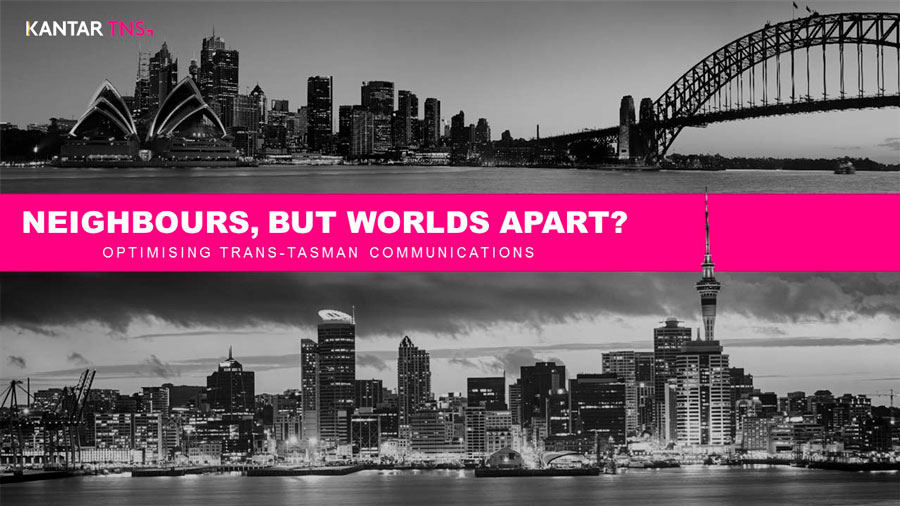Understanding differences – not similarities – between New Zealand and Australian markets is the key to more effective Transtasman marketing, according to new research from Kantar TNS.
Kantar TNS has released its Optimising Trans-Tasman Communications Effectiveness report today, revealing key insights for Transtasman marketers.
The agency’s NZ-based qualitative director Nicola Stokell says businesses marketing their products on both sides of the Tasman face a number of common issues.
“We often see examples of businesses who struggle to see why their campaigns perform differently in Australia and New Zealand and don’t know whether they are truly cost-effective or how to improve their overall effectiveness,” she says.
To find out the answers to these questions Kantar TNS embarked on a major piece of research involving a series of stakeholder interviews, a four-day online qualitative discussion board, an online quantitative survey of 1000 Australians and New Zealanders and desk research including insights from Kantar TNS’ Connected Life study.
“We needed to find out whether there were key differences between Australian and New Zealand cultural constructs, the competitive landscape, the equity of brands in each market or even media consumption and digital attitudes and behaviour,” Stokell said.
“The similarities between Kiwis and Aussies are often more obvious than the differences. Geographically we are close and we do have some shared history and culture relative to the rest of the world, and a semi-integrated economy.
“We both love the outdoors and are drawn to the same imagery of New Zealand beaches and road trips. We both see ourselves as very loyal, caring, open-minded, liking to treat everyone equally, confident, laidback and relaxed.”
Stokell says the research needed to dig deeper to answer the key questions ‘why are we seeing such differences in terms of the communication effectiveness – why do some Australian ads not travel well across the Tasman’?
“This revealed more pronounced differences around areas such as the cultural stereotypes we aspire to, humour, and our heroes and celebrities that did shed some light on the issue,” she said.
“As we know, typically Australian stereotypes are more fun-loving, cheeky, sarcastic and like to make fun of themselves. They are also more confident, brave and good at standing up for themselves.
“On the other hand Kiwi stereotypes stand out for their can-do attitude and being environmentally conscious. They are also seen as more adventurous, hands-on, family-focused and loyal.”
But Stokell says a critical factor is that stereotypes can sometimes feel very different to how we actually see ourselves.
“Australian stereotypes are cheeky, confident, brave and stand up for themselves. Kiwi stereotypes stand out for their can-do attitude, environmental consciousness, family focus and loyalty.”
Exaggeration
“It is the stereotypes that are often communicated in our advertising – typically an exaggerated expression of ourselves and our culture. The chances of disconnect are high if we can’t identify with what we see being communicated.”
The research also revealed a different view of heroes and celebrities. Australian heroes are high profile. Resilience, bravery, courage and confidence are admired, specifically the ability to transform in the face of adversity.
New Zealand heroes are typically everyday people – ‘my mum and dad’ – who are hard-working, loyal, caring and genuinely make a difference to their families and communities.
Like brands, TV celebrities can have different profiles and reputations on opposite sides of the Tasman and different celebrities can antagonise or win over different markets.
Valuable insights
Stokell says these differences, when coupled with some proven truths about the competitive landscapes of the two countries, really start to provide valuable insights.
For example, the New Zealand market has less competitive intensity and is more price conscious than Australia.
“Confectionary brands in Australia and New Zealand provide a great example of how the competitive landscape is rarely the same and brands often have different levels of familiarity and engagement in New Zealand versus Australia,” she says. “Their campaigns also highlight that superficial changes to localise such as voiceover dialect and product shots are often not sufficient to improve relevance.”
Based on the research, Kantar TNS’s top five tips to improve effectiveness of Transtasman communications are:
- Challenge cultural assumptions – stereotypes differ from reality
- Identify a unifying insight early on in the creative process
- Differences in brand equity can impact a campaign’s ability to travel
- Understand the competitive set for your brands in each market
- Be specific – culturally ambiguous communications often fail to resonate.
- Contact Nicola Stokell for a copy of the report: Nicola.Stokell@tnsglobal.com
About Kantar TNS
Kantar TNS New Zealand is a full-service market research based consultancy offering unique insight and in-depth understanding for businesses seeking growth strategies in across the Asia Pacific region. As part of a global community of over 80 countries, the New Zealand office integrates the best of Kantar TNS global expertise with its specific local market knowledge to deliver actionable insights. Kantar TNS is part of Kantar, WPP’s insight, information and consultancy group.
Share this Post



